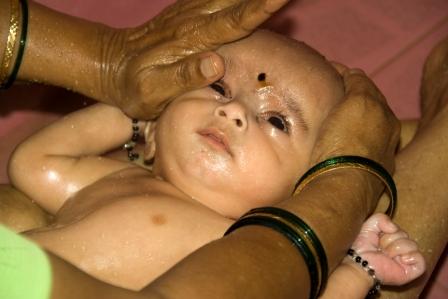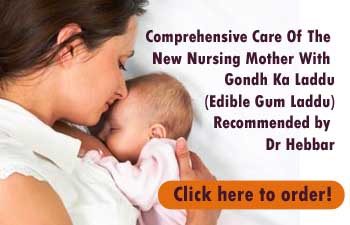Ayurvedic Care Of The Neonate: Initial Four Weeks
Article by Dr Raghuram Y.S. MD (Ay) and Dr Manasa, B.A.M.S
Soon after birth, the child is made to cry, vomiting is induced, vernix caseosa (external fat covering) is cleaned and umbilical cord is cut. After that, the below measures are taken up.

Table of Contents
Oil massage and bath
After this, the child should be smeared / massaged with Bala Taila (herbal oil).
After having applied the oil, the child should be bathed with any one of the lukewarm decoctions prepared with
1. latex yielding plants (ksheeree vriksha kashaaya),
2. water processed with fragrant herbs (sarva gandha udaka),
3. water dipped with heated bars of gold or silver (roupya hema pratapta vaari) or
4. with lukewarm decoction of kapitta patra (leaves of Citrus medica or citron fruit).
The Bathing water should be chosen keeping in view the dosha, kaala (time period, season) and vibhava (tolerance of the child)
Read related: 11 Mistakes To Avoid While Doing Oil Massage To Baby
Abhyanga-Snana helps in cleansing the body of the child in totality and removing the ulva (vernix caseosa) totally which otherwise cannot be removed just by wiping with water.
Swarna Prashana
Swarna Prashana: Licking of Swarna with honey, ghee and sarsaparilla:
धमनीनां हृदिस्थानां विवृतत्वादनन्तरम् |
चतूरात्रात्त्रिरात्राद्वा स्त्रीणां स्तन्यं प्रवर्तते ||१४||
तस्मात् प्रथमेऽह्नि मधुसर्पिरनन्तमिश्रं
मन्त्रपूतं त्रिकालं पाययेत्, द्वितीये लक्ष्मणासिद्धं सर्पिः, तृतीये च; ततः प्राङ्निवारितस्तन्यं मधुसर्पिः स्वपाणितलसम्मितं द्विकालं पाययेत् ||१५|| (सु.शा.१०/१५)
According to Sushruta –
Because the heart vessels of the mother are constricted soon after delivery, the lactation process may take 3 – 4 days of time.
After cutting the umbilical cord, the infant is comforted with cold water sprinkle.
After this, the child should be made to lick Suvarna Bhasma (ash of gold) mixed with Ghrita (ghee) and Madhu (honey). One should dip his sterile ring finger in the mixture of ghee, honey and ash of gold and allow the child to lick the finger.
Read related: Swarna Bindu Prashana: Ayurvedic Immunization Method
Praashana
Praashana (feeding the child)
ततः च ऐन्द्री ब्राह्मी शङ्खपुष्पी वचा कल्कं मधु घृतोपेतं हरेणु मात्रं कुश अग्र अभिमन्त्रितं सौवर्णेन अश्वत्थ पत्रेण मेधा आयुः बल जननं प्राशयेत्।
तद्वत् ब्राह्मी बला अनन्ता शतावर्य अन्यतम चूर्णे वा।(वाग्भट)
Praashana means feeding the child. It is done as below described –
- Paste of Aindri (Bacopa monnieri / Citrullus colocynthis), Brahmi (Centella asiatica / Bacopa monnieri), Shankapushpi (Convolvulus pluricaulis) and Vacha (Acorus calamus) should be prepared
- This paste should be mixed with Madhu (honey) and Ghrita (ghee)
- This mixture should be dipped with Kusha agra (tip of Kusha grass, Desmostachya bipinnata) and stirred while enchanting the holy hymns (abhimantrita) for the welfare of the child
- I harenu (250mg approximately) of this mixture should be taken in a spoon made of gold in the shape of ashwatta patra (leaf of Ficus religiosa)
- This should be cautiously fed to the child
- This mixture will increase ayu (life span), bala (strength) and medha (intellect) of the child
- One or all of the Brahmi, Bala (Sida cordifolia), Ananta (Hemidesmus indicus) and Shatavari (Asparagus racemosus) can be used in the same method explained above. Their paste shall be used.
Ayurveda suggests breast feeding on the 4th day. First day enchanted paste of ghee and honey mixed with swarna bhasma (gold ash) should be given for 3 times in a day. On 2nd and 3rd days Lakshmana Ghrita (ghee processed with Ipomoea sepiaria / Annona muricata) shall be given. On the 4th day unequal quantities of ghee and honey should be fed in a quantity which fits into the centre of the child’s palm. Following this the child should be given breast feeding (stanya pana).
Care of the nursing mother
In Rural India and in folklore Ayurveda practice, they make a laddu out of dry fruits, called Gondh Ki Laddu or Edible Gum Laddu.
It is administered from 2nd week till 3 – 4 months to improve strength and immunity of the nursing mother.
Jatakarma Samskaara
अथा अस्य जातकर्म प्राजापत्येन विधिना कुर्यात्।(वाग्भट)
Jaatakarma Samskaara comprises of all the traditional rituals, worships done for the benefit of the child.
Stana Pana
Stana Pana (breast feeding)
Stana Paana means breastfeeding. After Jaata Samskaara procedures, the mother should breastfeed the child.
Shrotra Snehana
Shrotra Snehana (oleating the ears)
अहः अहः च अस्य श्रोतृ शृङ्गाटकं स्नेह आप्लुतेन प्लोतेन प्रच्छादयेत्।(वाग्भट)
Shrotra Snehana means applying oil to the ear (outer and inner part of the ears). Everyday a sterile swab or gauze dipped in oil should be kept in the ear of the child. It should be placed in both ears.
Samveshanam
Samveshanam (sleeping the child)
प्राक् शिरसं च एनं क्षौम निचये संवेशयेद् उच्छीर्शके च अस्य अभिमन्त्रित कुम्भं स्थापयेत्, द्वार पक्षयोः च।(वाग्भट)
Samveshanam means resting or making the child to sleep. The child should be made to sleep on the comfortable and cushioned bed prepared by placing many soft clothes one over the other. The child should be placed on the bed such that the head points towards the East direction. Abhimantrita kumbha (a small vessel or pot having enchanted water) should be kept at the head end of the bed.
Read related: How To Improve Your Child’s Sleep? 16 Ayurveda Tips
Raksha Karma
Raksha Karma (protecting the child)
आदानी विदारी बदरी खदिर निम्ब पीलु परिइषक शाखाभिः एनं बीजयेत्।
ताभिः च समन्ततः सूतिकागारं परिवारयेत्।
सर्षप अतसी कणकाः च अन्तः बहिः प्रकेरेत्।
सायम् प्रातः च बलिम्।(वाग्भट)
Raksha Karma means measures taken to ‘protect the child from environmental infections and evil spirits’.
The branches with leaves of Aadaani, Vidari (Pueraria tuberosa), Badari (Indian Jujube), Khadira (Acacia catechu), Nimba (Neem), Peelu (Salvadora persica), Parushaka (Grewia asiatica) should be used to fan the child or they should be placed around the child in the sutikagara (labour room) or kumaragara (nursery, NICU or paediatric ward). They are believed to be natural disinfectants.
One should sprinkle the particles of Sarshapa (mustard), Atasi (Linseed) and Shali (rice) inside and outside the labour / nursery room.
Bali and Bhootpahara puja (rituals to bring about disinfection) should be done both in the morning and evening.
व्रणोक्तैः च गुग्गुलु आदि निर्धूपं कुर्यात्।
यथा ब्राह्मणो अथर्व वेद विद् दशाहं शान्ति कर्म कुर्यात्।
मायूरी, महामायूरी मार्या रत्नकेतु धारिणीं च उभय कालं वाचयेत्।(वाग्भट)
Fumigation with disinfectant herbs like Guggulu i.e. Commiphora mukul etc in Vrana Prakarana (wound management) should be administered
Shanti Karmas or Pacification rituals which nullify the bad effects and events should be done for 10 days in accordance with Atharva Veda rituals
Maayuri, Mahaamaayoori, Aaaryaa, Ratnaketu, Dhaarinee etc should be read around the child once in the morning and once in the evening
हिङ्गु वचा तुरुष्कर रक्षोघ्नैः पाटलीकाम् उत्तर देहल्यामासज्येत्।
कुमारस्य च सह मात्रा कण्ठे उच्छीर्षके च।
तद्वदार्या पर्ण शबरी मार्या अपराजितां च गो रोचनाभिः लिखितम्।(वाग्भट)
Hingu (asafetida), Vacha (Acorus calamus), Turushkara, Rakshoghna (mustard) should be tied in a cloth bolus and this bolus should be tied to the top of the frame of the entrance of the room or ward. Similar boluses should be prepared with same ingredients and tied around the neck of mother and child and also should be suspended from the cot.
The hymns or divine verses of Aarya, Parna Shabaree, Aarya Aparaajita Vidhya mantra should be written on Bhoja Patra (leaves of Betulis utilis) using Gorochana (bovine gallstones). These leaves should be suspended around the neck of mother, child and from the cot.
द्वारे च देहलीम् अनु तिर्यक् मुसलं निधापयेत्।
कणकण्डक तिन्दुक इन्धन अग्निं नक्तं दिवां च जागृयात्।
तथा अनुरक्ताः स्त्रियः सुहृदः च।
प्रहृष्ट जन सम्पूर्णं च तद् वेश्मं कार्यम्।(अ.सं.उ.१/२१)
A mortar should be obliquely placed over the threshold of the main entrance. The room or ward should be illuminated by burning the wood of Tinduka (Diospyos peregrine) during the day and also by evening. In the fire the particles of mustard and rice should be regularly sprinkled.
The affectionate relatives and women (who love the child) should be present in the premises. A happy environment should be maintained.
Click to Consult Dr Raghuram Y.S. MD (Ayu)
Food for the infant:
Namaste 🙂
What are the alternatives for baby formula?
Dr JV Hebbar
Wait a minute. Why we are in search of substitute for infant formula? The infant formula is a substitute for mother’s milk. Right?
For a newborn baby, till six months, if the mother is lactating properly, then there is no need of any baby formulas, as per Ayurveda.
मातुरेव पिबेत्स्तन्यं तद्ध्यलं देहवृद्धये ।
mātureva pibetstanyaṃ taddhyalaṃ dehavṛddhaye |
Ashtanga Hrudayam Uttara Tantra, 1/15
The mother only should feed the baby with her breast milk. That itself is sufficient for the development of the body of the infant.
There can be some situations where breast milk production (lactation) is not happening properly.
I have seen the worst cases of mothers, not being able to lactate for 2 – 3 weeks, being able to lactate with high doses of Shatavari granules, continuously given for many months. And also, mothers should still make an attempt to breastfeed the baby, even if only a few drops are secreted each day. This gives a positive feedback loop to the mother and required hormones will be released and eventually lactation will happen.
Patience and perseverance.
Motherly love and care
Positive mindset
Willingness and owning up the baby, thinking that mother is the last resort for the baby and there are no other options.
These positive feelings will surely win and cause sufficient lactation eventually.
Read: Ways to improve breast milk production
What if breastfeeding is impossible?
But still, in some cases where mother is ill or lactation is not happening, then, Acharya Vagbhata continues..
In the absence of breast milk of the mother,
two Dhatri (women who can feed the baby with their breast milk), who are
vatsale – who are affectionate
avyaṅge – not deformed,
brahmacāriṇyau – observing celibacy (avoiding sexual activities)
belonging to the same constitution (as of the mother),
nīruje – free of diseases;
of middle age, having living children
na lolupe – and not greedy,
hita āhāra vihāreṇa – who adhere to to healthy food, should feed the infant with love and care.
What if dhatri is unavailable?
स्तन्याभावे पयश्छागं गव्यं वा तद्गुणं पिबेत् ।
stanyābhāve payaśchāgaṃ gavyaṃ vā tadguṇaṃ pibet |
In the absence of breast milk, the infant should be given (boiled and cooled) milk of goat or cow.
So, the order of preference is – Mother’s milk, Dhatri’s milk or cow / goat milk.
The milk can be processed with
hrasvena pañcamūlena – boiled with herbs of hrsva pancaamula –
Shalaparni – Desmodium gangeticum
Prishniparni – Uraria picta
Brihati – Solanum indicum
Kantakari – Solanum xanthocarpum
Gokshura – Tribulus terrestris
Or can be processed with
saliparni – Desmodium gangeticum and
Prisniparni -Uraria picta
Small amount of candy sugar can also be added to it.










